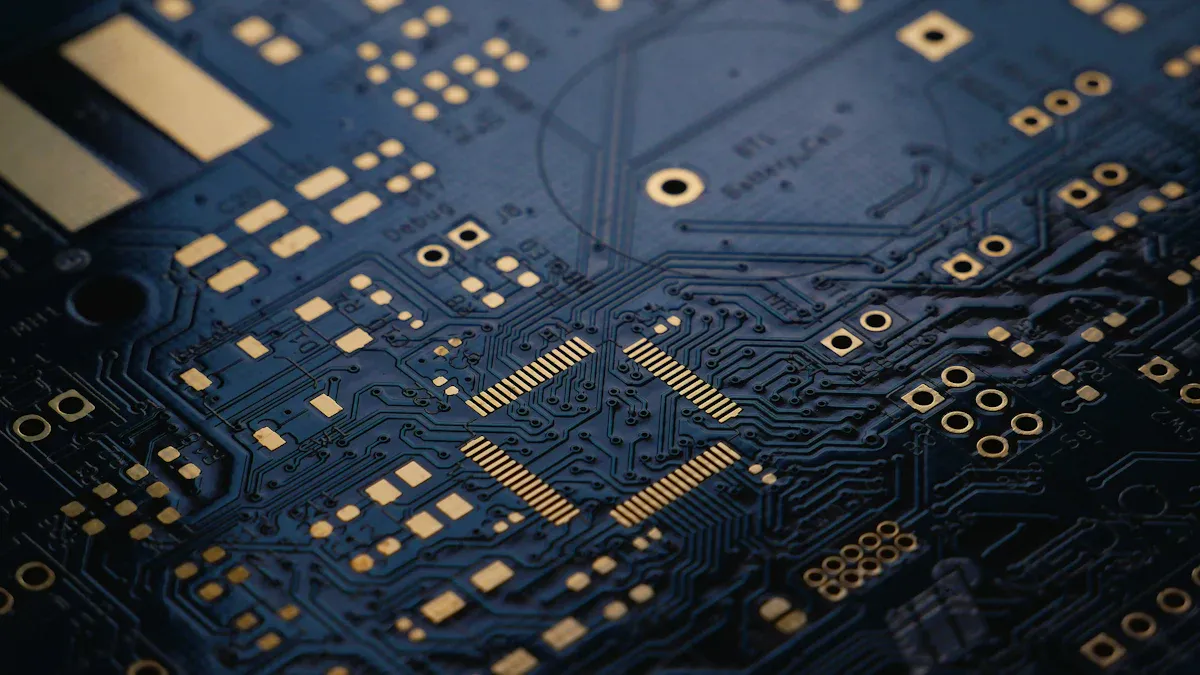
You use flexible printed circuits (FPCs) daily without noticing. These circuits help modern gadgets become smaller, lighter, and faster. Unlike stiff boards, FPCs can bend and fold easily. This makes them perfect for cool new designs. By 2024, FPCBs will make up 45.4% of the flexible materials market. They are key to making creative electronics, which will be 56.9% of the market. As technology improves, FPCs change how you enjoy electronics.
Key Takeaways
Flexible printed circuits (FPCs) are light and can bend easily. They are great for gadgets like smartphones and smartwatches.
FPCs work well in tough conditions. They resist heat, water, and chemicals, making them useful in cars and medical tools.
Using FPCs saves money by cutting material waste and making assembly easier. This helps factories work faster and better.
FPCs allow cool designs by fitting into tiny or tricky spaces. This helps add advanced features to electronics and smart devices.
The future of FPCs includes better materials and methods. These will improve how they work and make them eco-friendly for new electronics.
Understanding FPCs and Their Unique Features
What Is an FPC?
A flexible printed circuit (FPC) is a special type of circuit. It can bend and twist without breaking. Unlike hard boards, FPCs are made with thin, bendable materials like polyimide or polyester film. This makes them fit into small spaces and odd shapes. They are perfect for modern gadgets.
FPCs are made using advanced methods like electrohydrodynamic (EHD) printing. This process creates very tiny features, even smaller than the nozzle size. It works on micro and submicron levels. EHD printing uses many materials, like thick polymers and soft metals. By adjusting voltage and timing, makers get clear and steady results. For example, nano-silver circuits can be printed on flexible PET sheets. This shows how useful FPCs are for new technology.
How FPCs Differ from Traditional Circuit Boards
FPCs are different from regular circuit boards because of their special features. Both are important for electronics, but they are built and work differently. The table below shows their main differences:
Feature | Flexible Printed Circuits (FPCs) | Traditional Circuit Boards (PCBs) |
|---|---|---|
Thermal Conductivity | High | Moderate |
Heat Resistance | High | Moderate |
Dielectric Properties | Excellent | Good |
Mechanical Strength | High | Moderate |
Resolution | High (small line width/spacing) | Lower |
Aspect Ratio | High | Lower |
FPCs handle heat better and are stronger than regular boards. They also have great dielectric properties, making them last longer in tough conditions. FPCs can create finer details and higher aspect ratios. These features make them great for detailed and compact designs. Their flexible materials allow for creative designs that stiff boards cannot achieve.
Advantages of Flex PCB Design
Small and Lightweight Devices
Flexible circuits are great for making small, light gadgets. Their thin and bendable design saves space and cuts weight. Unlike stiff boards, flexible circuits fit tight spots and odd shapes. This makes them perfect for things like phones, fitness trackers, and portable devices.
You can stack layers into one compact unit with flexible circuits. This removes the need for extra parts and connectors. It also makes your device smaller and lighter. Using flex PCB design helps create efficient, easy-to-use products.
Strong and Tough in Hard Conditions
Flexible circuits are made to handle tough environments. Materials like polyimide and polyester resist heat, water, and chemicals. This makes them useful in cars, planes, and medical tools where strength matters.
Their flexibility helps absorb shocks and vibrations, avoiding damage. For example, in cars, they handle constant movement without breaking. This keeps devices working well, even in rough conditions.
Creative Designs for Special Uses
Flex PCB design allows for creative and custom designs. Flexible circuits can bend, twist, or fold to fit tricky spaces. They are perfect for unique and complex projects. Companies like BESTFPC make multilayer and rigid-flex circuits for advanced designs.
Flexible circuits meet detailed needs for special projects. BESTFPC shares tips on making rigid-flex PCBs, showing their skill in custom solutions. This flexibility helps you create innovative products that stand out.
Cost-Effectiveness in Mass Production
Flexible printed circuits (FPCs) save money when making many products. They are designed to lower costs while keeping good quality. This makes them great for industries needing lots of electronic parts.
Reduced Material Waste
FPCs use thin, light materials like polyimide and polyester films. These materials create less waste during production. Unlike regular circuit boards, FPCs are made to fit exact shapes. This smart material use cuts costs and helps the environment.
Tip: Using FPCs can save money and support eco-friendly production.
Simplified Assembly Process
The flexible design of FPCs removes the need for big connectors. Multiple layers can be combined into one circuit. This makes assembly faster and cheaper. For example, in gadgets, FPCs help make small designs without losing features.
Lower Shipping Costs
FPCs are small and light, making them easy to ship. You can send more at a lower cost than regular boards. This is helpful for companies shipping products worldwide.
Long-Term Savings
FPCs last longer, needing fewer repairs or replacements. They resist heat, water, and vibrations, lowering damage risks. Investing in FPCs saves money on fixes and keeps devices working longer.
Scalability for High-Volume Production
FPCs are great for making many products quickly. Roll-to-roll methods help produce large amounts efficiently. This keeps quality high and costs low. Industries like cars and electronics use FPCs to meet big demands affordably.
Note: Using FPCs helps make budget-friendly products without losing creativity.
Applications of FPCs in Modern Electronics

Wearable Devices and Medical Innovations
Flexible printed circuits (FPCs) are important in wearables and medical tools. They bend easily, fitting curved surfaces like human skin. This makes them great for health monitors like ECG and EMG devices. New materials, like gallium-indium liquid metal, improve their performance. These materials conduct electricity well and stretch up to 600%. This strength helps in electrode patches, LED lights, and heaters.
In medical tools, FPCs are used in pacemakers and hearing aids. They fit into small, curved spaces, making devices more comfortable. Flexible circuits help doctors monitor patients better. They also improve diagnostic tools, leading to better healthcare.
Automotive and Aerospace Advancements
FPCs are changing cars and airplanes with lightweight, strong designs. In cars, they are used in cameras, sensors, and control systems. They handle heat and vibrations, working well in tough conditions. For example, FPCs keep car systems running smoothly despite constant movement.
In airplanes and satellites, FPCs reduce weight, saving fuel and boosting performance. They are tough enough for extreme conditions, making them vital for space and defense. Their durability ensures reliable use in these industries.
Consumer Electronics and IoT Integration
FPCs are key in gadgets like phones, tablets, and cameras. They save space and make devices more reliable. The demand for smaller, flexible devices is growing fast. Better materials and methods have made FPCs stronger and more efficient.
In IoT, FPCs connect sensors and communication parts. This helps devices share data easily. Smart homes and fitness trackers use FPCs for compact designs. Energy-saving materials in FPCs also reduce power use, helping the environment.
Industrial Automation and Robotics
Flexible printed circuits (FPCs) are important in automation and robotics. Their special features help make efficient, reliable, and small systems for factories and robots.
Why FPCs Are Important in Automation
FPCs are flexible and strong, perfect for nonstop working machines. They bend and twist without breaking, making them great for robotic arms. These circuits handle repeated movements and vibrations, lasting a long time.
Tip: Adding FPCs to machines lowers repair costs and boosts reliability.
Main Benefits of FPCs in Robotics
Compact Designs: FPCs remove the need for big wires and connectors. This helps create smaller, faster robots.
Strong Materials: Polyimide resists heat, chemicals, and wear. Robots with FPCs work well in tough places like hot or chemical-filled factories.
Better Precision: FPCs allow detailed circuits, helping robots do delicate jobs. They can assemble tiny parts or handle fragile items carefully.
Real-Life Uses
FPCs are used in robotic arms for tasks like welding and painting. They also power sensors that check machines, keeping them safe and efficient. In warehouses, FPCs help robots move and sort packages accurately.
Note: FPCs are key to Industry 4.0, where smart factories use connected systems.
Using FPCs helps build smarter, better automation systems. These circuits improve performance and allow for creative robot designs.
How FPCs Are Changing Electronics Design
Making Devices Smaller and Easier to Carry
Flexible printed circuits (FPCs) help make smaller, lighter gadgets. Their thin and bendable design fits into tight spaces. They work well in odd shapes, perfect for portable devices. Gadgets like smartphones, smartwatches, and earbuds use FPCs. You get small devices without losing performance.
FPCs can stack layers into one compact piece. This removes the need for big connectors, saving space. For example, wearables use FPCs for slim, comfy designs. Their lightweight build is great for devices you carry around.
Adding Advanced Features to Small Gadgets
FPCs add advanced features without making gadgets bigger. They handle detailed circuits for better screens and faster processors. Foldable phones use FPCs to stay functional while bending often.
These circuits are also very reliable. They resist heat and vibrations, keeping devices working well. In IoT gadgets, FPCs connect sensors and parts smoothly. This helps smart homes and wearables work efficiently. You get small gadgets with powerful features.
Helping the Environment with Green Designs
FPCs support eco-friendly electronics by cutting waste. Makers use renewable materials like cellulose for biodegradable circuits. Safer chemicals reduce harm to the environment.
New production methods use only needed materials, cutting waste. Embedded parts lower the number of components, saving resources. Renewable energy is also used in making FPCs, reducing pollution.
Tools like Life Cycle Assessment (LCA) check environmental impacts. This ensures FPCs are made sustainably. With FPCs, you get cool gadgets that are also good for the planet.
The Future of Flex PCB Design
New Trends in FPC Technology
Flexible printed circuits (FPCs) are changing fast with better materials. One cool trend is using PEDOT:PSS, a special polymer. This material works well in flexible screens, wearables, and solar panels. Over 35% of its use is in organic electronics because it conducts electricity well. Flexible screens and wearables make up another 22%, showing the need for smaller, flexible gadgets. Cars are also using this tech, with touch sensors making up 11% of demand.
Asia-Pacific is leading in FPC progress, holding over 45% of the market. Countries like China and South Korea are top in electronics production. This region is a hotspot for new ideas. These trends show how FPCs are shaping future technology for homes and industries.
Solving Problems in FPC Development
Making FPCs has challenges, but new ideas are solving them.
Liquid metals are improving flexible circuits. They conduct electricity well and stretch without breaking.
These metals stay stable under pressure and connect to hard parts without heat.
They allow detailed designs and layers, opening new uses for FPCs.
Still, liquid metals have issues like oxide layers that lower conductivity. Making tiny channels is also tricky. Scientists are fixing these problems with semi-embedded liquid metal particles. These methods make liquid metals stronger and easier to use in flexible circuits.
FPCs in Future Electronics
FPCs are helping create amazing new technologies. Materials like liquid metal-vitrimer composites make circuits tougher and recyclable. These materials let you reshape circuits while keeping them working. This is important for flexible wearables and smart city tools.
As gadgets become part of daily life, FPCs will help make them smarter and greener. FPCs will lead the next big wave of tech changes.
Flexible printed circuits (FPCs) are changing modern electronics in big ways. They help make small, strong, and creative designs for many uses. From health trackers to cool gadgets, FPCs improve devices while keeping them light and easy to carry. As technology grows, FPCs will shape smarter and greener electronics. Their flexibility ensures they stay important for future device designs.
FAQ
Why are flexible printed circuits (FPCs) better than regular boards?
FPCs are light, bendable, and strong. They fit small spaces and odd shapes, unlike stiff boards. They handle heat, shaking, and tough conditions well. This makes them great for modern gadgets like wearables, medical tools, and car systems.
Can FPCs work in tough environments?
Yes, FPCs work well in harsh places. Materials like polyimide resist heat, water, and chemicals. This makes them perfect for planes, cars, and factories where strength is needed.
Tip: Use FPCs for devices facing heat or constant movement.
Are flexible circuits good for the environment?
FPCs help the planet by cutting waste and using green materials. Makers often use biodegradable parts and energy-saving methods. This lowers the harm electronics cause to nature.
How do FPCs make wearables better?
FPCs make wearables light, small, and comfy. They bend to fit curved spots like wrists or skin. They also add cool features like sensors and wireless tech in tiny designs.
Which industries use FPCs the most?
Healthcare, cars, planes, and gadgets depend on FPCs. These circuits boost performance, cut weight, and allow creative designs. They are also key for IoT and robots.
Note: FPCs are vital for industries needing small, strong, and smart electronics.
See Also
Simplifying Flex And Rigid-Flex PCBA Production Processes
Benefits And Obstacles Of Implementing PCBA In Electronics
Essential Technologies Shaping PCBA Production For Today’s Electronics





